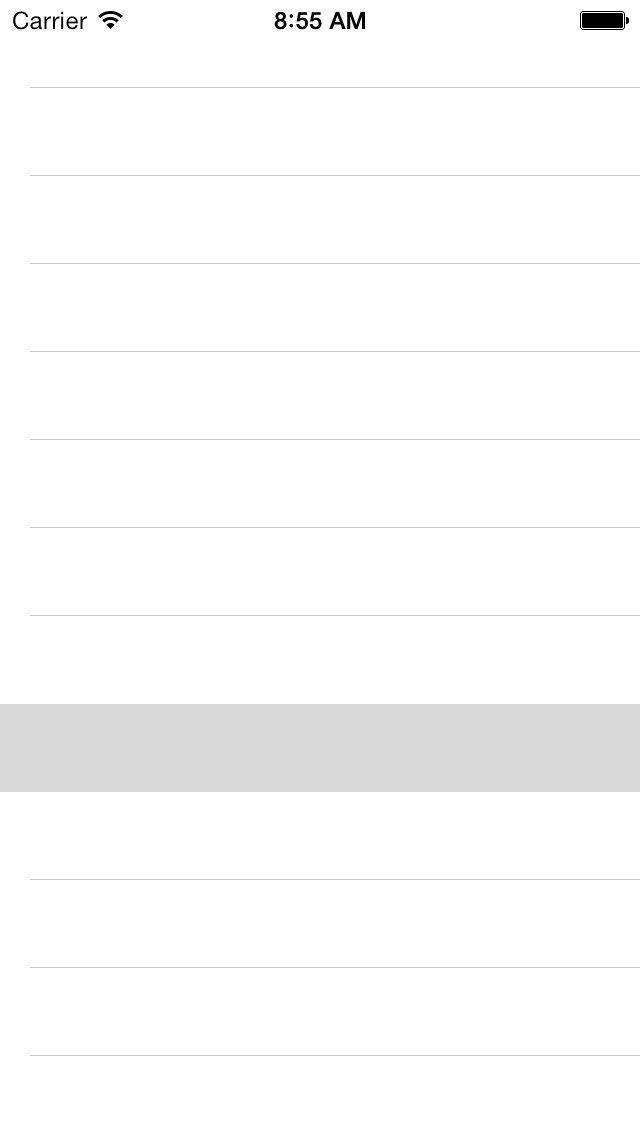列表显示,顾名思义它是在一个列表视图的形式显示在屏幕上的数据的内容。于ios在列表视图UITableView达到。这个类在实际应用中频繁,是很easy理解。这里将UITableView的主要使用方法总结一下以备查。
UITableView定义在头文件UITableView.h中,详细的定义能够查看官方文档;从定义中能够看出,UITableView继承自UIScrollView类,因此在支持方便地显示列表数据的同一时候,还天生支持垂直滚动操作。
组成列表的每个元素称为UITableViewCell实例。
一个UITableViewCell也是应用很广泛的类,定义可见官方文档。
在详细的使用过程中,能够创建一个独立的UITableView,也能够直接创建一个UITableViewController。这里主要记录创建UITableView的方法,下篇记录通过列表视图控制器使用UITableView。
UITableView类中定义了style属性:
@property(nonatomic, readonly) UITableViewStyle style
typedef enum {
UITableViewStylePlain,
UITableViewStyleGrouped
} UITableViewStyle;每个列表视图的组成都是相似的,都是由一个表头视图+表体+表尾视图构成。当中表头和表尾两个视图默觉得nil。须要时能够创建自己定义视图加入到表头和表尾。定义例如以下:
@property(nonatomic, retain) UIView *tableHeaderView;
@property(nonatomic, retain) UIView *tableFooterView;以下简单新建一个demo展示一下怎样创建一个UITableView。
这里假定大家都了解xcode的基本操作,所以就不再一步一步地截图了,简单叙述就可以。不懂得能够去百度一下“xcode新建project”。
新建一个single view application。在新生成的ViewController.m文件里重写loadView方法,新建一个UITableView视图。
(别忘了把alloc的视图在dealloc函数中释放。)
- (void)loadView
{
CGFloat width = [UIScreen mainScreen].bounds.size.width;
CGFloat height = [UIScreen mainScreen].bounds.size.height;
UIView *backgroundView = [[UIView alloc] initWithFrame:CGRectMake(0, 0, width,height)];
self.view = backgroundView;
_tableView = [[UITableView alloc] initWithFrame:CGRectMake(0, 0, width, height) style:UITableViewStylePlain];
[self.view addSubview:_tableView];
[_tableView release];
}编译执行。显演示样例如以下图:
表视图的协议方法——这是很重要的部分,由于我们创建一个表视图,目的就是让视图能够显示数据,否则一个空空的表视图与废物无二。表视图所定义的协议方法由代理方法delegate和数据源方法data source方法组成。
托付方法一般用于实现个性化处理表视图的基本样式(如单元格的高度等)以及捕捉单元格选中的响应。数据源方法用于完毕表中的数据。如指定单元格数。以及创建每个单元格。
要实现代理和数据源方法。首先须要让当前视图控制器支持UITableViewDelegate和UITableViewDataSource协议。做例如以下改动:
@interface ViewController : UIViewController<UITableViewDelegate,UITableViewDataSource>
_tableView.delegate = self;
_tableView.dataSource = self;delegate和data source协议有两个方法是必须实现的:
- (UITableViewCell *)tableView:(UITableView *)tableView cellForRowAtIndexPath:(NSIndexPath *)indexPath;
- (NSInteger)tableView:(UITableView *)tableView numberOfRowsInSection:(NSInteger)section;实现这两个方法是想要在表视图中显示数据必须实现的最低要求。
我们在视图控制器头文件里声明一个NSArray *model(retain属性),并在viewDidLoad中将[UIFont familyNames]赋给这个属性。
在视图控制器中实现这两个代理方法:
- (NSInteger)tableView:(UITableView *)tableView numberOfRowsInSection:(NSInteger)section
{
return [_model count];
}
- (UITableViewCell *)tableView:(UITableView *)tableView cellForRowAtIndexPath:(NSIndexPath *)indexPath
{
static NSString *identify = @"TableViewCell";
UITableViewCell *cell = [tableView dequeueReusableCellWithIdentifier:identify];
if (nil == cell)
{
cell = [[UITableViewCell alloc] initWithStyle:UITableViewCellStyleDefault reuseIdentifier:identify];
cell.textLabel.text = self.model[indexPath.row];
}
return cell;
}编译。执行,显示结果:
假设希望实现对选中某个单元格的响应,仅仅须要实现以下代理方法就可以。在代理方法中能够实现创建新的视图控制器并控制其载入到屏幕上。
- (void)tableView:(UITableView *)tableView didSelectRowAtIndexPath:(NSIndexPath *)indexPath;版权声明:本文博主原创文章,博客,未经同意不得转载。
























 387
387

 被折叠的 条评论
为什么被折叠?
被折叠的 条评论
为什么被折叠?








